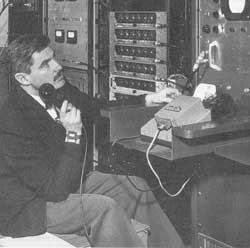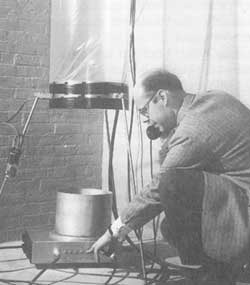The Weight of Light

In honor of the World Year of Physics, which commemorates Einstein’s “miraculous year” in 1905, we’re presenting papers from the Physical Review archive related to Einstein’s accomplishments.
Before he worked out the general theory of relativity, Einstein had already deduced that gravity must affect a light wave’s frequency and wavelength. Light moving upwards from Earth’s surface, for example, shifts to longer wavelength and lower frequency, as gravity saps it of some energy. But the effect is tiny in earth’s modest gravity. In 1960 Robert Pound and Glen Rebka of Harvard University finally succeed in testing this crucial prediction, and they reported their results in PRL. Today the so-called gravitational redshift is essential for understanding the cosmos and operating the Global Positioning System (GPS).
Imagine a pulse of light emitted downward from the top of a cliff just as a diver jumps. By the time the light reaches the ground, the diver will have gained speed and will regard a detector stationed on the ground as moving upward. According to the diver, the light source was stationary when it emitted the pulse, but the detector is racing upwards toward the light pulse at the moment of detection. So the detector should see the light’s frequency increased by the Doppler effect.

Relativity says that only an observer in freefall, who is weightless and feels no acceleration or gravity, is in an “impartial” reference frame. The stationary physicists operating the experiment aren’t qualified to judge the relative motion between source and detector because they experience gravity, which can be mimicked by accelerated motion of the ground and cliff. These physicists call the change in the light’s frequency a gravitational redshift rather than a Doppler effect.
To measure this minuscule change, physicists had to find a source of electromagnetic radiation whose frequency was known with enormous precision. That ingredient came in 1959 when Rudolf Mössbauer at the Max Planck Institute in Heidelberg, Germany, discovered the effect that bears his name and won him a Nobel prize two years later. Excited atomic nuclei can decay to the ground state by emitting a gamma ray. Mössbauer found that if the nuclei are part of a high quality crystal, then every gamma ray emerges with precisely the same energy. Another sample with nuclei in the ground state can then absorb the gamma rays, but only if there is no velocity difference between emitter and absorber. Any relative velocity will mean, because of the Doppler effect, that the absorber sees a gamma ray of the wrong frequency, and can’t take it up.
Pound and Rebka placed an emitter at the top of a tower in the Jefferson Physical Laboratory at Harvard and installed a detector 74 feet below. By measuring the detection rate as they jiggled the emitter up and down slightly, the researchers could find the velocity difference between source and detector that compensated for the gravitationally induced change of frequency.
By reversing their experimental set-up to also measure the frequency shift of gamma rays going up the tower, Pound and Rebka could eliminate several sources of experimental error. The difference between the up and down measurements–a frequency change of only a few parts in 1015--represented the pure gravitational effect and matched Einstein’s prediction to 10 percent accuracy. By 1964 they had improved the agreement to within one percent [1].
This was a “major scientific achievement,” says Clifford Will of Washington University in St. Louis, not only because it was a classic test of relativity, but because of the ingenious experimental design. And there is a practical consequence, he adds. The satellite-borne clocks of the GPS navigational system must be regularly corrected for changes induced by gravitational redshift. So relativity calculations keep every freighter and fighter jet on course.
–David Lindley
David Lindley is a freelance science writer, now retired. His most recent book is The Dream Universe: How Fundamental Physics Lost Its Way (Penguin Random House, 2020).
References
- R. V. Pound and J. L. Snider, “Effect of Gravity on Nuclear Resonance,” Phys. Rev. Lett. 13, 539 (1964)
More Information
C. M. Will, Was Einstein Right? (Basic Books, New York, 1986)R. V. Pound, “Weighing Photons, I,” Physics in Perspective 2, 224 (2000)R. V. Pound, “Weighing Photons, II,” Physics in Perspective 3, 4 (2001)


